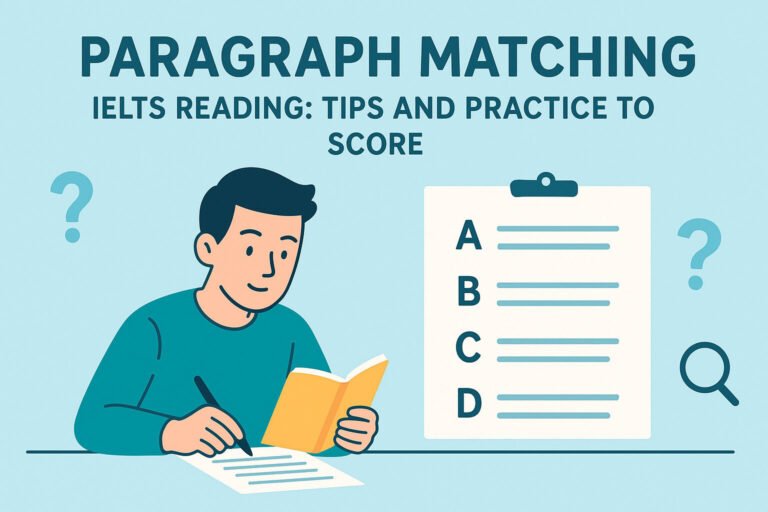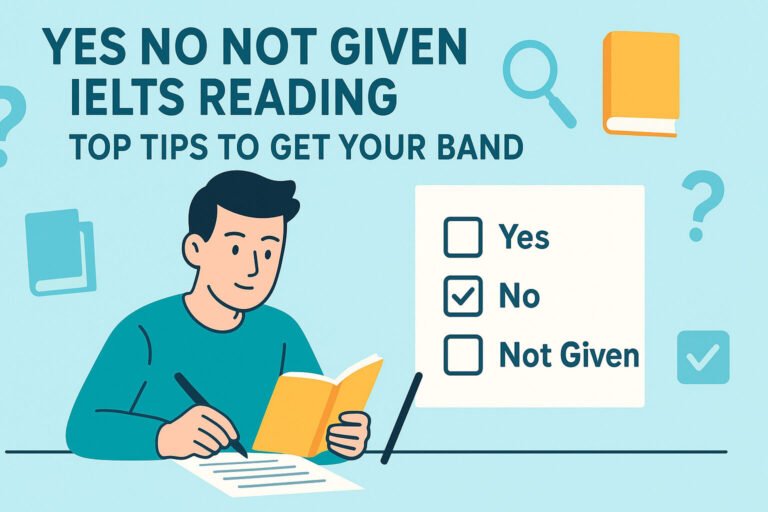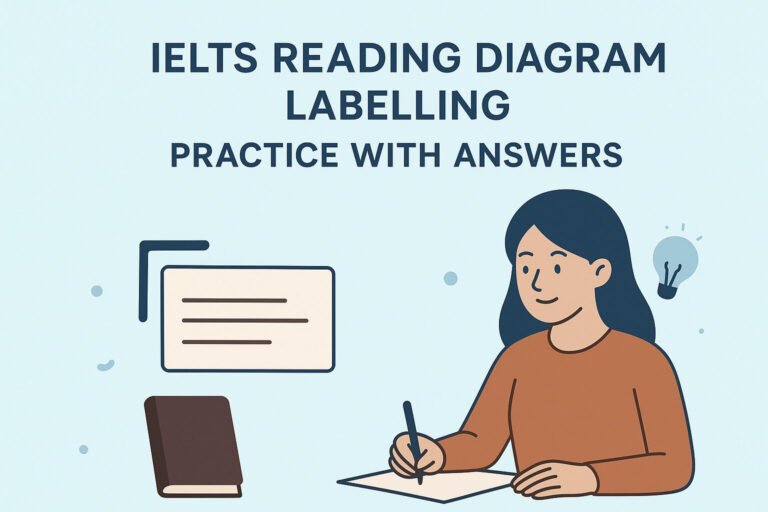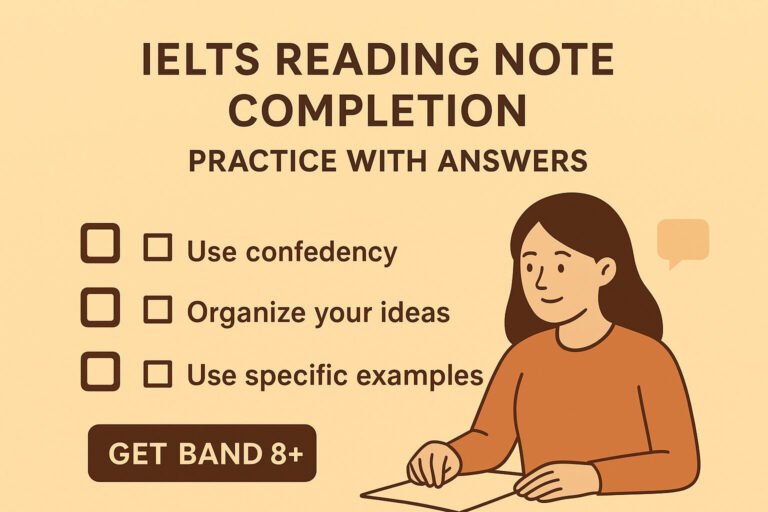Are you staring at a flowchart in your IELTS Reading practice, feeling like you’re lost in a maze? Don’t worry—you’re not alone! Flow-chart completion questions in the IELTS Academic Reading section can feel tricky, but they’re a golden opportunity to score high with the right approach. This guide will break down everything you need to know about IELTS Reading Test: Flow-chart Completion Questions, from understanding the task to mastering it with practical tips and sample answers. By the end, you’ll feel confident tackling these questions like a pro. Ready to ace your IELTS Reading? Let’s dive in!
What Are Flow chart Completion Questions in IELTS Reading?
Flow-chart completion questions are a common task in the IELTS Academic Reading section. You’re given a flowchart summarizing a process, sequence, or cycle described in the passage, and you must fill in the blanks with words or phrases from the text. These questions test your ability to locate specific information, understand logical sequences, and paraphrase key ideas.
Why do they matter? Flow-charts often appear in passages about scientific processes, historical events, or technical procedures—topics that align with academic study. Mastering them shows examiners you can handle complex information, a crucial skill for university success.
Flow-chart completion tests your precision and comprehension. With practice, it’s a predictable, score-boosting task.
👉 Join Our Telegram Channel to Download IELTS Academic/General PDF and Audios
🎧 Includes all Listening Audios + Speaking Videos + Answer Explanations + Writing Samples.
Why Flow chart Completion Questions Feel Tricky
Many IELTS aspirants find IELTS Academic Reading Flowchart Completion challenging because:
Complex Vocabulary: Passages often use technical or academic terms.
Paraphrasing: The flowchart uses different wording from the passage, requiring you to spot synonyms.
Sequence Confusion: Understanding the order of steps can be tough, especially under time pressure.
Time Management: Skimming for answers while maintaining accuracy is a balancing act.
But here’s the good news: with a clear strategy, these questions become manageable. This guide will equip you with step-by-step tips to conquer them.
Flow-charts seem tough, but they follow a pattern you can learn to crack.
Step-by-Step Strategy for Flow chart Completion
Here’s a foolproof method to tackle IELTS Reading: Flow-chart Completion questions effectively. Follow these steps during practice and on test day.
Step 1: Skim the Flowchart First
Before diving into the passage, glance at the flowchart to understand its structure. Is it a process (e.g., how a solar panel works), a cycle (e.g., the water cycle), or a timeline (e.g., stages of urban development)? Note the number of blanks and any keywords already provided.
Example: If the flowchart describes “stages of coffee production,” expect words like harvesting, roasting, or packaging.
Step 2: Scan the Passage for Relevant Sections
Flow-charts usually correspond to a specific part of the passage. Look for headings, subheadings, or paragraphs that match the flowchart’s topic. Use the flowchart’s keywords to guide you.
Tip: Underline signal words like first, next, finally, or subsequently in the passage—they often indicate sequence.
Step 3: Match Synonyms and Paraphrases
The flowchart won’t use the exact words from the passage. For example, if the passage says “the beans are roasted,” the flowchart might require “roasting” or “heat treatment.” Build your synonym vocabulary during preparation.
Example: Passage: “The liquid is filtered to remove impurities.” Flowchart answer: filtration.
Step 4: Check Word Limits
Flow-charts typically ask for one to three words per blank. Always double-check the instructions to avoid losing points for exceeding the limit.
Step 5: Verify the Sequence
Ensure your answers align with the flowchart’s order. If the flowchart shows Step 1 → Step 2 → Step 3, your answers must follow the same logic.
A systematic approach—skim, scan, match, check—makes flow-chart completion straightforward.
Sample Academic Reading Flow chart Completion
Let’s walk through a sample question to see the strategy in action. Below is a simplified example inspired by typical IELTS passages.
Passage Excerpt (fictional): The process of making paper begins with harvesting timber from sustainable forests. The wood is then debarked and chipped into small pieces. These chips are cooked with chemicals to produce pulp, which is cleaned and refined. Finally, the pulp is pressed and dried to create paper sheets.
Flowchart Task: Complete the flowchart using no more than two words from the passage.
Harvesting timber
Chipping wood
Pressing pulp
Answers: 2. Debarking wood4. Cooking pulp6. Drying sheets
Explanation:
For blank 2, “debarked” in the passage is paraphrased as debarking wood.
For blank 4, “cooked with chemicals to produce pulp” becomes cooking pulp.
For blank 6, “dried to create paper sheets” is simplified to drying sheets.
Practice matching passage details to flowchart blanks using synonyms and concise phrasing.
Top 5 Tips for IELTS Reading Flowchart Completion
Here are five practical tips to boost your performance in IELTS Reading Flowchart Completion with Tips & Practice:
Build Vocabulary for Processes: Learn terms related to common IELTS topics like science, technology, and history (e.g., extraction, synthesis, evolution).
Practice Skimming and Scanning: Time yourself to locate relevant passage sections in under a minute.
Use Context Clues: Look for sequence markers (then, afterward) to guide your answers.
Double-Check Word Count: Stick to the word limit to avoid penalties.
Mock Tests Are Key: Practice with authentic IELTS materials from sources like Cambridge IELTS.
Consistent practice with these tips builds speed and accuracy for flowchart tasks.
Common Mistakes to Avoid
Even prepared students make errors. Here’s what to watch out for:
Ignoring Word Limits: Writing “cooking the pulp” instead of cooking pulp loses marks.
Misreading the Sequence: Filling blanks out of order disrupts the flowchart’s logic.
Overcomplicating Answers: Choosing long phrases when a single word suffices.
Missing Paraphrases: Failing to recognize synonyms like “filtered” for purified.
Takeaway: Avoid these pitfalls by practicing with real IELTS questions and reviewing your mistakes.
Practice Exercise for Flow-chart Completion
Try this mini-exercise to apply what you’ve learned. Use the passage below to complete the flowchart.
Passage: Recycling glass begins with collecting used bottles and jars. These are sorted by color to ensure purity. Next, the glass is crushed into small pieces called cullet. The cullet is melted in a furnace and molded into new products.
Flowchart:
Collecting bottles
Crushing glass
Molding products
Answers (check after trying): 2. Sorting color4. Melting cullet
Regular practice with exercises like this sharpens your flowchart-solving skills.
Table: Common IELTS Flow-chart Topics and Vocabulary
Topic | Common Vocabulary | Example Flowchart Step |
|---|---|---|
Scientific Processes | Extraction, synthesis, filtration | Filtering impurities |
Environmental Cycles | Evaporation, condensation, precipitation | Condensing vapor |
Historical Events | Colonization, revolution, reformation | Reforming policies |
Manufacturing | Assembly, packaging, distribution | Assembling components |
Familiarize yourself with these topics and terms to spot answers quickly.
FAQ: Your Flow-chart Completion Questions Answered
Here are answers to common questions about IELTS Academic Reading Flowchart Completion, optimized for Google’s People Also Ask:
1. What is a flow-chart completion question in IELTS Reading?
It’s a task where you fill in blanks in a flowchart summarizing a process or sequence from the passage, using a limited number of words.
2. How many words can I use for flow-chart answers?
Typically, one to three words, but always check the instructions. Exceeding the limit costs points.
3. How do I find the right part of the passage?
Skim the flowchart for keywords, then scan the passage for matching sections, focusing on sequence markers like first or next.
4. Are flow-chart questions only in IELTS Academic?
Yes, they’re exclusive to the Academic Reading test, often tied to scientific or technical passages.
5. Can I practice flow-chart completion online?
Yes, websites like IELTS Nest offer practice tests, and Cambridge IELTS books provide authentic materials.
6. What if I don’t understand the passage’s vocabulary?
Focus on context clues and synonyms. Practice academic vocabulary for common IELTS topics to improve comprehension.
These FAQs address key concerns, helping you prepare confidently.
Final Thoughts and Your Next Steps
Mastering IELTS Reading Test: Flow-chart Completion Questions is all about strategy and practice. By skimming flowcharts, scanning passages, matching synonyms, and sticking to word limits, you’ll turn a tricky task into a score-boosting opportunity. Start practicing with authentic IELTS materials, review your mistakes, and build your vocabulary for common topics. You’re closer to your dream study-abroad score than you think!
Ready to level up your IELTS Reading skills? Try a free practice test on IELTS Nest and apply these tips today. Share your progress in the comments or ask for more advice—let’s ace IELTS together!











